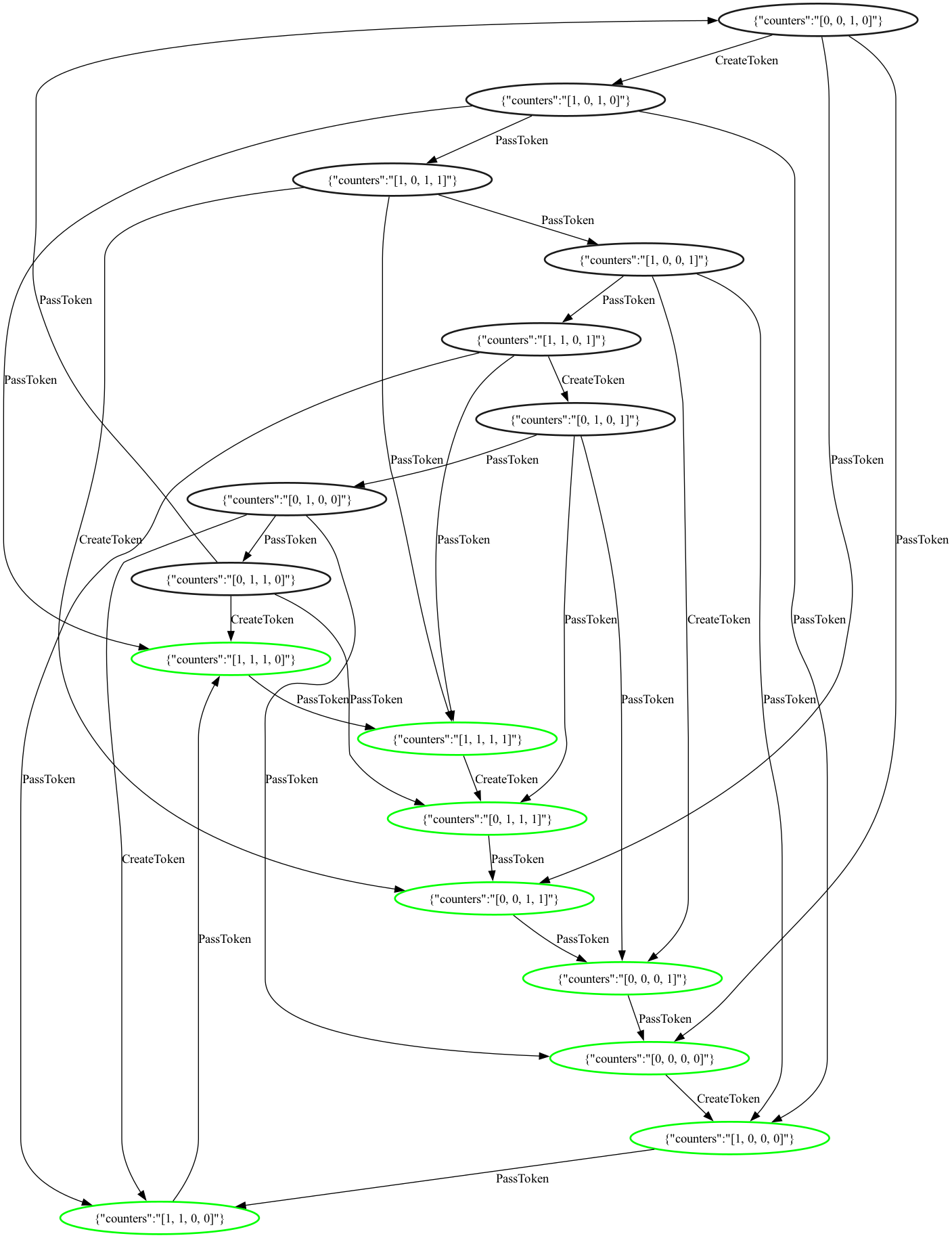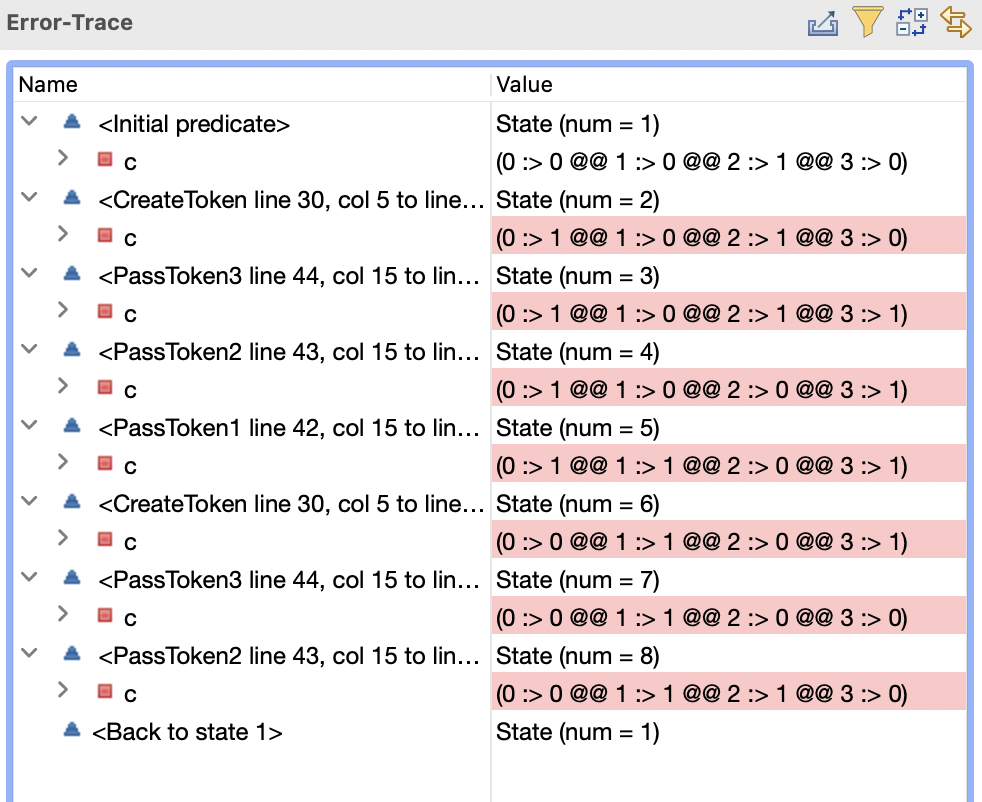Strong fairness
jayaprabhakar k
The spec has two actions - CreateToken and PassToken. The spec as given, fails liveness property if N < M - 1. The trace looks reasonable.

1. Once the stable (green) nodes are reached, there is no way to reach an unstable (black) node.
And, from every action here is Strong Fair, the link should be enabled infinitely often, and so one of the transitions should happen eventually.
---
Init ==
/\ c \in [ Node -> 0 .. M-1 ]
CreateToken ==
(* Node 0 executes this action to inject new value into system *)
/\ c [0] = c [N-1]
/\ c' = [ c EXCEPT ![0] = (c[N-1]+ 1) % M ]
PassToken(i) ==
(* Other nodes just copy value of the predecessor *)
/\ i # 0
/\ c [i] # c [i-1]
/\ c' = [ c EXCEPT ![i] = c[i-1]]
PassTokens ==
\E i \in Node \ {0} : PassToken(i)
PassToken1 == c [1] # c [0] /\ c' = [ c EXCEPT ![1] = c[0]]
PassToken2 == c [2] # c [1] /\ c' = [ c EXCEPT ![2] = c[1]]
PassToken3 == c [3] # c [2] /\ c' = [ c EXCEPT ![3] = c[2]]
---------------------------------------------------------------------------------------
Next ==
\/ CreateToken
\/ PassToken1
\/ PassToken2
\/ PassToken3
Spec == Init /\ [][Next]_vars /\ SF_vars(PassToken1) /\ SF_vars(PassToken2) /\ SF_vars(PassToken3) /\ SF_vars(CreateToken)
---------------------------------------------------------------------------------------
UniqueToken ==
\E i \in 0 .. N : \* unique token at i (or i=N => token is at 0)
/\ \A j \in 0..i-1: c[j]= c[0] \* before i all c equals c[0]
/\ \A j \in i..N-1: c[j]= (c[0]-1) % M \* after i all c following c[0]
(* Stabilization property *)
Stab == <>[]UniqueToken
The error trace:

<<
[
_TEAction |-> [
position |-> 1,
name |-> "Initial predicate",
location |-> "Unknown location"
],
c |-> (0 :> 0 @@ 1 :> 0 @@ 2 :> 1 @@ 3 :> 0)
],
[
_TEAction |-> [
position |-> 2,
name |-> "CreateToken",
location |-> "line 30, col 5 to line 31, col 47 of module TokenRing"
],
c |-> (0 :> 1 @@ 1 :> 0 @@ 2 :> 1 @@ 3 :> 0)
],
[
_TEAction |-> [
position |-> 3,
name |-> "PassToken3",
location |-> "line 44, col 15 to line 44, col 59 of module TokenRing"
],
c |-> (0 :> 1 @@ 1 :> 0 @@ 2 :> 1 @@ 3 :> 1)
],
[
_TEAction |-> [
position |-> 4,
name |-> "PassToken2",
location |-> "line 43, col 15 to line 43, col 59 of module TokenRing"
],
c |-> (0 :> 1 @@ 1 :> 0 @@ 2 :> 0 @@ 3 :> 1)
],
[
_TEAction |-> [
position |-> 5,
name |-> "PassToken1",
location |-> "line 42, col 15 to line 42, col 59 of module TokenRing"
],
c |-> (0 :> 1 @@ 1 :> 1 @@ 2 :> 0 @@ 3 :> 1)
],
[
_TEAction |-> [
position |-> 6,
name |-> "CreateToken",
location |-> "line 30, col 5 to line 31, col 47 of module TokenRing"
],
c |-> (0 :> 0 @@ 1 :> 1 @@ 2 :> 0 @@ 3 :> 1)
],
[
_TEAction |-> [
position |-> 7,
name |-> "PassToken3",
location |-> "line 44, col 15 to line 44, col 59 of module TokenRing"
],
c |-> (0 :> 0 @@ 1 :> 1 @@ 2 :> 0 @@ 3 :> 0)
],
[
_TEAction |-> [
position |-> 8,
name |-> "PassToken2",
location |-> "line 43, col 15 to line 43, col 59 of module TokenRing"
],
c |-> (0 :> 0 @@ 1 :> 1 @@ 2 :> 1 @@ 3 :> 0)
]
>>
divyanshu ranjan
--
You received this message because you are subscribed to the Google Groups "tlaplus" group.
To unsubscribe from this group and stop receiving emails from it, send an email to tlaplus+u...@googlegroups.com.
To view this discussion on the web visit https://groups.google.com/d/msgid/tlaplus/CA%2Bt%3DSi%2B11pQwgXkCZdnB_q%3DNdS1XCVEumqd7tPLO%2B28R1%3Ddegg%40mail.gmail.com.
jayaprabhakar k
To view this discussion on the web visit https://groups.google.com/d/msgid/tlaplus/CAL9hw27Wg%3Dz7gJOQGQ_tt%3Dcr_Lnnw-mVHgbSqanURbzxcR4jcA%40mail.gmail.com.
divyanshu ranjan
To view this discussion on the web visit https://groups.google.com/d/msgid/tlaplus/CA%2Bt%3DSiJ9PHkK5kfC34ZLK8tUr17P8KL0FB6BwXQB03cjbmkOUA%40mail.gmail.com.
Stephan Merz
On Mar 13, 2024, at 09:58, jayaprabhakar k <jayapr...@gmail.com> wrote:
Hi,I am trying out Dijkstra's Self Stabilizing for Token ring algorithm.https://muratbuffalo.blogspot.com/2022/10/checking-statistical-properties-of.html
The spec has two actions - CreateToken and PassToken. The spec as given, fails liveness property if N < M - 1. The trace looks reasonable.Looking at the state space, making these two actions as Strong Fair should fix the liveness issue, but it doesn't seem to.Listing out all the states,
---
The error trace:
Stephan Merz
jayaprabhakar k
Thanks for the nice visualization, which allows one to understand what’s going on.Each of the actions CreateToken, PassToken(1), PassToken(2), and PassToken(3) is taken along the counter-example that TLC produces, so clearly your strong fairness hypotheses are satisfied in the counter-example, while stabilization does not occur.
If you’d like to ensure that the black subgraph is left eventually, you’ll certainly need a stronger fairness assumption. If I understand correctly, the green states correspond to those in which UniqueToken holds. This suggests definingSpec == Init /\ [][Next]_vars /\ SF_vars(Next /\ UniqueToken’)which requires that stabilization will occur given that it is "often enough" possible to achieve stabilization in a single step. Of course, it is entirely unclear how you would implement such a fairness condition.
To view this discussion on the web visit https://groups.google.com/d/msgid/tlaplus/747484B9-34E1-4FB8-BD3F-B2A58AC83A5A%40gmail.com.
